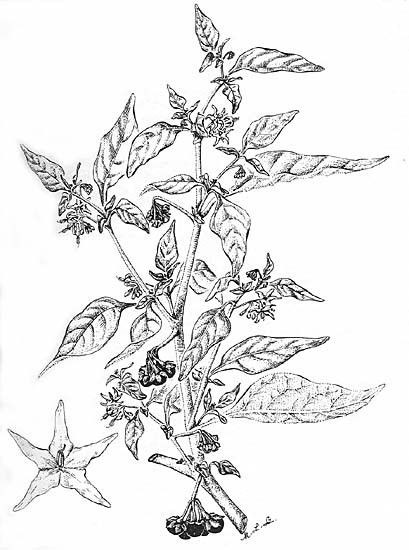 Line drawing by M. Szent Ivany, J. Adelaide Bot. Gards 4 (1981) 45, fig. 4. |
 Distribution map generated from Australia's Virtual Herbarium. |

Synonymy
*Solanum chenopodioides Lam., Tabl. Encycl. 2: 18 (1794)
T: Mauritius; holo: P, Herb. Lam., n.v., fide C.D. Morton, Revision Argentine Sp. Solanum 145 (1976), photo ADW.
S. gracile Dunal, in DC., Prodr. 13(1): 54 (1852), non S. gracile Sendtner, in Martius, Fl. Bras. 10: 13 (1846); S. gracilius Herter, Rev. Sudam. Bot. 7: 226 (1943), based on S. gracile Dunal.
T: Rio de Janeiro, Brazil, Gaudichaud 520; syn: G–DC, P n.v., fide J.M. Edmonds, J. Arnold Arbor. 52: 226 (1971); Buenos-Aires, Argentina, Commerson; syn: P n.v., fide J.M. Edmonds, loc. cit.; Montevideo, Uruguay, Commerson & Gay; syn: P n.v., fide J.M. Edmonds, loc. cit.; cultivated Montpellier; lecto: G–DC n.v., fide R.J.F. Henderson, Contr. Queensland Herb. 16: 46 (1974), Austrobaileya 1: 20 (1977).
Description
Sprawling perennial herb to 1 m, green or grey-green, pubescent with simple hairs; prickles absent.
Leaves ovate to lanceolate, the lamina usually 4–7 cm long, and 2–4 cm wide, discolorous, entire or shallowly lobed; petiole to 5 cm long.
Inflorescence short, 5–10–flowered; peduncle 1–2 cm long, slightly longer in fruit; pedicels 5–8 mm long. Calyx 1–3.5 mm long; lobes rounded, 0.5–1.5 mm long. Corolla deeply incised, 12–20 mm diam., white. Anthers 2.5–3.5 mm long.
Berry globular, 5–9 mm diam., black. Seeds 1–1.8 mm long, light brownish-yellow. n=12.
Distribution and ecology
Native to Argentina; naturalised in North America, Europe, Australia and N.Z.
Occurs in coastal and subcoastal areas of south-eastern Qld, N.S.W. and eastern Vic. Grows in gullies and on river banks.
Common name
Whitetip Nightshade
Relationships
Part of the S. nigrum or "Black nightshade" group of species, usually referred to as cosmopolitan weeds and usually thought to have originated in the Americas. They are characterised by their lack of prickles and stellate hairs, their white flowers and their green or black fruits arranged in an umbelliform fashion.
The species can be difficult to distinguish. Other species to occur in Australia are S. americanum, S. douglasii, S. furcatum, S. nigrum, S. opacum, S. physalifolium, S. retroflexum, S. sarrachoides, S. scabrum and S. villosum.
A useful reference to the Black Nightshades is J. M. Edmonds & J. A. Chweya, The Black Nightshades. Solanum nigrum and its related species. Int. Plant. Genetic Res. Inst. Rome (1997).
Some members of the complex have long been important food and medical sources in parts of Africa,
References: Keller, G.B. (2004). African nightshade, eggplant, spiderflower et al. - production and consumption of traditional vegetables in Tanzania from the farmer's point of view. MSc dissertation,
Notes
Asphondylia obscura Kolesik, a gall midge, causes galls in the fruits of S. chenopodioides and S. physalifolium var. nitidibaccatum.
Kolesik, P., McFadyen, R.E.C. & Wapshere, A.J. (2000). New gall midges (Diptera: Cecidomyiidae) infesting native and introduced Solanum spp. (Solanaceae) in
Selected specimens
Qld: Brisbane, R. Henderson 301 (BRI). N.S.W.: near Bodalla, L. Haegi 1756 (AD, NSW); near Nelligen, R. Pullen 3964 (CANB). Vic: East Gippsland, A.C. Beauglehole 37803 (MEL). S.A.: Lower Torrens Valley, Feb. 1997, D. Symon 15462 (AD).
From the web
Further information and images of this species in NSW can be seen on the PlantNET site.
Further photographs and images of herbarium specimens of S. chenopodioides can be found on the Solanaceae Source site.
Pictures of flowers and fruits can be seen in the Botany Section of the La Société Guernesiaise website.
An early engraving of the species can be seen in the JCB Archive of Early American Images